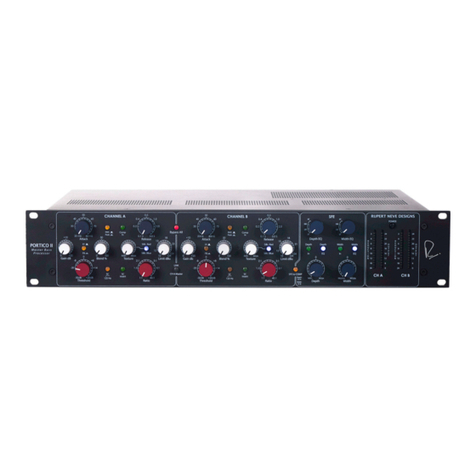
9
impedance causes the high frequencies to roll off due to leakage inductance in the transformer in
addition to the above amplier distortion (This can be an advantage with some microphones!).
For this reason we have provided a high value of input impedance that will load microphones to the
smallest possible extent and makes the best possible use of that limited “Phantom” 48-volts supply.
A NOTE ON DISTORTION
The human hearing system is a remarkably complex mechanism and we seem to be learning more
details about its workings all the time. For example, Oohashi demonstrated that arbitrarily ltering out
ultrasonic information that is generally considered above our hearing range had a measurable effect on
listener’s electroencephalo-grams. Kunchur describes several demonstrations that have shown that our
hearing is capable of approximately twice the timing resolution than a limit of 20 kHz might imply
(F=1/T or T=1/F). His peer reviewed papers demonstrated that we can hear timing resolution at
approximately with 5 microsecond resolution (20 kHz implies a 9 microsecond temporal resolution,
while a CD at 44.1k sample rate has a best-case temporal resolution of 23 microseconds).
It is also well understood that we can perceive steady tones even when buried under 20 to 30 dB of
noise. And we know that most gain stages exhibit rising distortion at higher frequencies, including
more IM distortion. One common IM test is to mix 19 kHz and 20 kHz sine waves, send them through
a device and then measure how much 1 kHz is generated (20-19=1). All this hints at the importance
of maintaining a sufcient bandwidth with minimal phase shift, while at the same time minimizing
high frequency artifacts and distortions. All of the above and our experience listening and designing
suggest that there are many subtle aspects to hearing that are beyond the realm of simple traditional
measurement characterizations.
The way in which an analog amplier handles very small signals is as important as the way it behaves
at high levels. For low distortion, an analog amplier must have a linear transfer characteristic, in other
words, the output signal must be an exact replica of the input signal, differing only in magnitude. The
magnitude can be controlled by a gain control or fader (consisting of a high quality variable resistor
that, by denition, has a linear transfer characteristic.) A dynamics controller - i.e. a compressor,
limiter or expander - is a gain control that can adjust gain of the amplier very rapidly in response to
the uctuating audio signal, ideally without introducing signicant distortion, i.e. it must have a linear
transfer characteristic. But, by denition, rapidly changing gain means that a signal “starting out” to be
linear and, therefore without distortion, gets changed on the way to produce a different amplitude.
Inevitably our data bank of “natural” sound is built up on the basis of our personal experience and
this must surely emphasize the importance of listening to “natural” sound, and high quality musical
instruments within acoustic environments that is subjectively pleasing so as to develop keen awareness
that will contribute to a reliable data bank. Humans who have not experienced enough “natural”
sound may well have a awed data bank! Quality recording equipment should be capable of retaining
“natural” sound and this is indeed the traditional measuring stick. And “creative” musical equipment
should provide the tools to manipulate the sound to enhance the emotional appeal of the music without
destroying it. Memory and knowledge of real acoustic and musical events may be the biggest tool and
advantage any recording engineer may possess.
One needs to be very careful when one hears traces of distortion prior to recording because some avors
of distortion that might seem acceptable (or even stylish) initially, may later prove to cause irreparable
damage to parts of the sound (for example, “warm lows” but “harsh sibilance”) or in louder or quieter





























